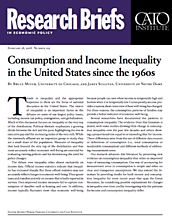To address concerns about measurement error in consumption, we build on recent evidence showing that some components of consumption reported in survey data compare quite favorably to national accounts, both in levels and in changes over time. Other components are sharply underreported with this bias increasing over time. We construct a way of measuring consumption that relies on the wellmeasured components. These components represent an important share of overall consumption — they include key components of consumption such as food at home, housing, and vehicles. Even though several other studies rely on subsets of total consumption, they rarely test the conditions under which distributional statistics for these subsets can be extrapolated to total consumption. In order to draw conclusions about changes in consumption inequality from evidence on the well-measured components, it is critical that these components are equally important for high and low consumption households. It is also important that price changes for well-measured consumption mirror the changes for overall spending. The data indicate that both these conditions hold: well-measured consumption is roughly a constant share of overall consumption throughout the distribution, and the price of the bundle of well-measured goods has not changed noticeably relative to the prices for all goods.
We report measures of inequality for income and consumption over the past five decades, using income data from the Current Population Survey and consumption data from the Consumer Expenditure Interview Survey. We investigate inequality patterns in different parts of the distribution by reporting ratios of percentiles, which are not sensitive to errors in the extreme tails of the distribution. In particular, we focus on the ratio of the 90th percentile to the 10th percentile (the 90/10 ratio), the 90/50 ratio, and the 50/10 ratio. Thus, our analyses do not capture changes in the extreme tails of the distribution.
Our results for income show that the way one measures income has a significant effect on changes. Accounting for taxes considerably reduces the rise in income inequality since 1963. Accounting for noncash benefits, using data available only since 1980, has only a small effect on changes in income inequality, likely due to increased underreporting of transfer income at the bottom.
Using our improved ways of measuring consumption, we show sharp differences in the patterns for consumption and income inequality. Since the early 1960s, the rise in income inequality as measured by the 90/10 ratio (29 percent) has significantly exceeded the rise in consumption inequality (7 percent). Furthermore, this much smaller percentage increase in consumption inequality started from a considerably lower base. In some decades, such as the 1960s and 1990s, income and consumption inequality moved in parallel, but in other decades the differences were sharp. In the 1980s, inequality for both measures rose, but the increase was much greater for income (28 percent) than for consumption (5 percent). After 2005 these measures moved in opposite directions as income inequality rose sharply while consumption inequality fell. The differences between income and consumption through 2005 are almost exclusively in the bottom half of the distribution, indicating that the underreporting of consumption by the rich is not an explanation for the differences.
We also consider several possible explanations for the differences in inequality patterns. We decompose the changes in income and consumption inequality to determine the extent to which the patterns can be explained by changing demographics. These decompositions show that changing demographics can account for some of the changes in consumption inequality, but they account for few of the changes in income inequality. We do find that the divergence between income and consumption inequality measures is almost exclusively concentrated in single-parent-headed families and single individuals, who have the largest increases in income inequality but the largest declines in consumption inequality. Consumption smoothing is not consistent with differences between income and consumption at the very bottom, but the declining quality of income data plays an important role. Changes in asset prices likely account for some of the differences between the measures in recent years for the top half of the distribution.
Our evidence of only a modest rise in consumption inequality over the past five decades contrasts sharply with Thomas Piketty and Emmanual Saez’s evidence from tax data that an increasing share of the nation’s income is going to the very highest income families; though several papers using broader and more consistent measures of income in tax data do not show large increases in the top 1 percent income share. Our analyses are distinct from these studies that focus on the highest income households. We do not include the extreme tails of the distribution because resources are likely to be poorly measured in survey data for these observations. Tax data alone are also unsuitable for measuring incomes at the bottom since they miss nonfilers and important sources of income such as TANF, SSI, SNAP, and housing benefits, which are not taxable.
Most of the discussion around recent trends in inequality highlights growing dispersion. However, the evidence from consumption data indicates that changes in inequality in economic well-being is more nuanced than a simple story of rising dispersion throughout the distribution. Rather, in the bottom half of the distribution there is little evidence of rising consumption inequality, and in the top half of the distribution the rise in consumption inequality has been much more modest than the rise in income inequality, particularly since 2000. In light of the deficiencies of income and the contrast with consumption, policymakers should look beyond income when assessing the need for policy changes.
NOTE:
This research brief is based on Bruce Meyer and James Sullivan, “Consumption and Income Inequality in the U.S. since the 1960s,” Becker Friedman Institute Working Paper no. 2017-12, September 2017.

